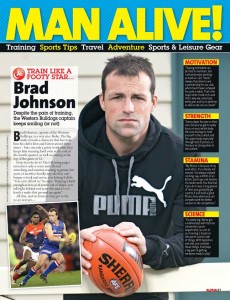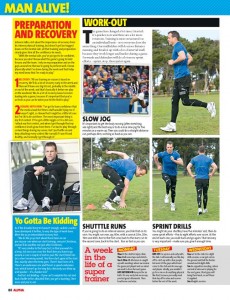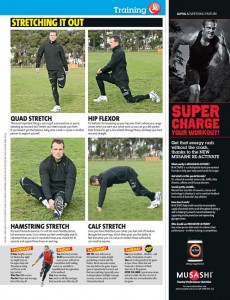 Train Like An AFL Player
Train Like An AFL Player
AFL players are among the fittest athletes there are, and Brad Johnson was getting on in years, so an ideal person to ask how he stays at it. A good bloke, too. We stood in the middle of a windswept Melbourne field, while he ran around happily – and a miserable sponsor’s rep told me to hurry up. Written in 2009 for Alpha magazine. The photographer was David Rosendale.
________
Brad Johnson, captain of the Western Bulldogs and very nice bloke. The big smile reveals a character that has won him the best and fairest award three times – but conceals a gritty work ethic that keeps him running hard even at the end of games, and playing at the top of the game at 32.
How does he do it? The following pages reveal not only a scary and efficient stretching and stamina training regimen, but years of sacrifice: hardly any alcohol, one burger a week and never, ever letting it slide: “You can’t afford to – training’s hard enough as it is, so if you’re out of shape, you fall right behind everyone else and it’s too hard to make that ground up again.”
And we haven’t even got to the yo-yo test yet…
Motivation
“It is hard to maintain, but I certainly enjoy working as hard as I can and there’s always that drive there to win a premiership for or club which hasn’t been achieved for quite a while. That’s the major drive and that’s why we come back every year and try to perform as well as we can as a team.”
Strength
“Every player focuses on their core, but you’ve got to really focus on your whole body, to be honest. The core and the legs to hold yourself in the contest; the upper body, especially bench press, so that you’re strong in the contest.”
 Stamina
Stamina
“My fitness is because of my work ethic, it’s certainly not natural. I’ve always enjoyed running, say, a 400m or an 800m, but to go a bit further, it’s harder work. You find that if you do it over a long period of time, you gradually get used to it and build a good fitness base where you can compete with the better runners in the competition.”
Technology
“It’s pretty big. We’ve got a relationship with Victoria University’s sports department, so a lot of our training is based on the sports science side of things now. And with hydration and diet, you combine all those things now, it all plays a big part in getting everyone ready to play.”
Preparation and recovery
Johnson talks a lot about the importance of recovery from his intense physical training, but doesn’t get too bogged down on the mental side: all that training and preparation clearly gives him all the confidence he ever needs.
“ With the mental side, you’ve just got to be confident, because you don’t know what the game’s going to hold for you and the team. I rely on my preparation and on the guys around me that we’re going to perform well. I’m not very big on the whole visualisation thing. I just know physically what I’ve done during the week and that helps my mind know that I’m ready to play.”
1. Recovery: “All our training in-season is based on recovery. We’ll do a lot of recovery early in the week and then we’ll have one big hit-out probably in the middle or end of the week, and that’s basically it before we play on the weekend. We do a lot of recovery-based sessions leading into a game, because it’s important that you’re as fresh as you can be when you hit the field to play.”
2. Dealing with pain: “I’ve got to have confidence that the medical and the fitness staff wouldn’t play me if I wasn’t right, so I know that I might be a little bit sore but I’m OK to be out there. The most important thing is my first contest. If I’ve got a little niggle or I’m a bit sore, I attack your first contest and when I get through that my confidence levels grow from there. If I’ve got something wrong I usually heal fairly quickly. I’ve had to play through certain things during my career, but I just battle on and keep attacking every contest like I would if I was fit and healthy, and normally I get through it.”
 Work-out
Work-out
“The game has changed a lot since I started; it’s quicker now and there’s a lot more rotations. Training is now more structured on an individual basis – not everyone does the same thing. Our midfielders will do more distance running and break it up with a lot of interval stuff, because they work longer and harder during a game. Forwards and defenders will do a lot more sprint efforts – sprint, stop, then sprint again.”
Slow Jog
It’s important just to get the body moving (after stretching, see right) and the best way is to do a nice slow jog for three-five minutes as a warm-up. Then you could do a straight distance run – perhaps 4km, which you build through and work as hard as you could. But you can also do an interval run – sprint for 15 secs, jog for 15 seconds.
Shutttle Runs
Shuttles are good because they build a lot of fatigue in your body, and you know you’re going to have a good work-out. If you’re going to do an interval session you’d do that on its own and that would be it. You might run over, say, 40m – a cone at 10m, 20m, 30m and 40m. Run to the first cone, back to the start, run to the second cone, back to the start… That’s fantastic for building speed-endurance. You’d run as fast as you could.
Sprint Drills
You might do your shuttles, then five minutes rest, then some sprint efforts – five to eight efforts over 100m. At the end you walk back and go again. That recovery is very important – make sure you give it enough time, whether it’s a walk back or a drink, then go again.
Brad Johnson’s week
Monday
10am At the club for injury clinic.
11am Walk some laps and do a good stretch.
1-3.30pm All afternoon is caught up with meetings where we review the game just played and see what we need to do leading into the next game.
Late afternoon: jump in the ice bath, then head home and relax. The ice bath is very unpleasant – probably the worst part of our footy. But when you get out you feel fantastic and your body’s fully recovered.
Tuesday
Day off. With kids I’m up nice and early. I normally use that day to catch up with a few people, but most guys will at least come to the club and do massage and physio on the day as well. You wouldn’t go for a run or do anything physical. You need that day off to relax and recover.
Wednesday
9am Get to the club. Do a light skills session, so we get out on the ground and kick the footies around and do some light drills.
1pm Have an opposition meeting, where we look at who we’re playing for the next game. Most guys will bring their lunch, or we’ll have it supplied.
3pm Weights session.
Thursday
8.30 Wake up early and get to the club for a weights session. On Wednesday night we might focus on the upper body and Thursday morning we’ll focus on the legs.
10-11am We’ll have a skills session and then that’s it for the day. With skills development we’ll break up into various groups and some guys will do marking, or we’ll have our midfielders do some stoppage work; we’ll have the defenders do some spoiling and marking. It’s very specific on that day to what position you play.
11am-1pm Physio and massage.
Friday
9am Get to the club for our main footy session. Get strapped and ready for the session.
10.30 Session starts and we’ll train for about an hour. It’s our main session, with all our competitive stuff, tackling and so on, and drills to hopefully beat the opposition at the weekend.
12pm Team meeting.
2pm Lunch is a little bit later and guys can do what they want after that.
Saturday
Day off. Guys will come info some treatment, maybe do some light goal kicking or some touch with the footies. Every club varies, but we’ll always do our main session two days before the game. It gives guys an opportunity a day to recover and only come into the club to fine-tune anything.
I generally just come in and get some physio and light massage, some recovery sessions, and an ice bath and get the body feeling really good for the game. I feel pretty relaxed.
Sunday
9am Get up. Have breakfast – Weetbix and I usually have a coffee on game day just to wake up a bit. I start to hydrate and drink plenty of water to get going.
12pm Get to the ground for the game at 2pm. The last thing I have on the way into the game is usually a Mars Bar for the sugar hit, plus a Powerade. When I get to the ground I keep drinking a lot of fluids.
After the game – a good warm-down and and an ice bath to start the recovery process. We also eat – a lot of chocolate bars and lollies or sandwiches straight after the game.
Stretching
Quad stretch
The most important thing is you’ve got a nice posture, so you’re standing up nice and tall. Stretch your heel towards your bum. If you haven’t got the balance, hang onto a wall or a pole or another person, to support yourself.
Hip Flexor
It’s fantastic for loosening up your hip area and that’s where your range comes when you start your sprint work so you can go a bit quicker. Push forward to get a nice stretch through there, and keep your back nice and straight.
Hamstring stretch
My least favourite exercise! I’m not the most flexible person, but everyone varies. Go to where you feel comfortable and it’s important that you don’t overstretch that area. Hold it for eight-10 seconds and repeat three times each leg. The more you repeat it the more length you’ll get in your stretch.
Calf stretch
Once you’ve stretched your calves, you feel a lot of freedom through the lower legs, which then gives you the ability to feel free when you run.
Nutrition
“Nutrition is a huge thing. We’ve got a dietician at the club who looks after that area, but most guys have an understanding of what foods and how much they need to be hydrated for a game and for training. We know exactly the right foods to eat to give us that energy to perform well in training and a game.
Early in the week I eat the normal vegetables, steaks, stir-fries. Always leading into a game I load up on my carbohydrates, a lot of pasta, some lasagne and guys eat a lot of rice dishes and potatoes to really build their carbohydrate loading so they’ve got the energy to run out a game.
After a game we’re given the all-clear to eat whatever we feel like at that time. But the next day it’s back on track and I have a substantial breakfast that gets me going again.
If I am going to have junk food I’ll have it the night after a game. I might go home and have a pizza or something like that. Or the kids might grab a McDonald’s on the way home and I might pinch a burger there. But apart from that, it’s the only time I’ll go near it.
My whole career I haven’t really touched a drink during the season. Maybe two or three times throughout the season I might have a couple of beers. I just feel that it affects me too much leading into training and preparing for next week’s game. Anything less than an eight-day break and I won’t go near it.
A typical day’s food
Breakfast: Six Weetbix in the morning, with a couple of glasses of water.
Mid-morning: Fruit or a muffin just to keep going.
Lunch: “Usually a couple of nice-sized sandwiches to fill up. Some guys will have pasta.
After training: most guys will load up on some lollies or chips just to get something back into the system. A lot of guys eat fruit, especially in the afternoon.
Dinner: I’ll have a big dinner; I’m lucky that my wife is a fantastic cook, so she varies it a fair bit. But the single guys have to cook for themselves or each other. Most guys, especially earlier in the week will have chicken, risotto and that sort of stuff.
Before bed: “A nice bowl of ice-cream – I’m a sucker for that. I’ve done it ever since I was young. Generally I’m lucky in that I can eat anything and eat as much as I want and I don’t put on weight – and I don’t really lose too much. I’ve stayed the same for a long time.”
Yo Gotta Be Kidding
As if the dreaded beep test wasn’t enough, sadistic coaches have developed it further, to vary the type of work done – and make it harder to jump-start the beep. Meet the yo-yo intermittent recovery test.
“We do the yo-yo test about three times in our pre-season: one when we start training, so we can get a base on where all the guys are at when they get back off holiday; one pre-Christmas when we’ve done a fair bit of training and we’ll do another one probably just after Christmas.
“It is very similar to the beep test, in that you work to a beep, but once you cross the finish line you have to go around a cone a couple of metres past the start/finish line (as a short recovery period), then it makes you start again at the start line, exactly when the beep goes. There’s two forms of it. There’s an endurance one and there’s a speed-endurance one, which doesn’t go for long, but obviously you blow up a bit quicker; it’s probably a harder test.”
He’s not kidding – if you can’t complete the out and back shuttle in the allocated time, you get a warning. Once more and you’re out.
________
See this as PDFs: